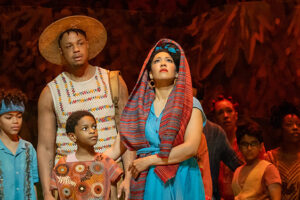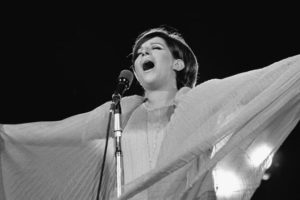

In that year, Goyescas had its world premiere at the Met (on a double-bill with Pagliacci, starring Caruso—Goyescas had to settle for Martinelli) and four further performances. Then, full of honors and ambition (his Atlantide unfinished), Granados sailed triumphantly home on the HMS Sussex, which was torpedoed by a U-boat.
Thus, Granados joined the little band of early twentieth-century composers of genuine operatic gift who, for whatever reason (it’s rarely a U-boat), failed to provide the world with the major operatic masterpiece or slew of masterpieces they seemed likely to devise. I list him with Bartok, Szymanowski, Weinberger, Grecchi, Braunfels, Rachmaninoff, Shostakovich. Gershwin and Hanson as someone whose achievement was worthy of more and mightier successors—and let us add Montsalvatge as well, for his adorable El Gato con Botas.
“Goyescas,” the title, refers to Goya’s caricatures of life, low and high, in the streets of Madrid: Humans of Old Spain, their pose, their expression, their furtive, soulful eyes, their pride and their fall from pride. Granados was inspired by many of these drawings to compose a series of piano vignettes, some busybody provided a libretto and the tunes stayed in, with vocal lines.
To set the mood, as if Spanish rhythms and folk tunes were not enough, a chorus comments, gossips, moralizes, while performing picturesque activities. The picturesque clichés were not quite so travelogue familiar in 1916, and Bare Opera was right to dispense with them. Besides, they only had a four-person chorus, who were kept on book off central stage, and their warbling (plus surtitles) provided the background.
A low budget, alas, meant bare cinderblock had to stand in for the Puerta del Sol or wherever this is taking place, but to distract us there were three dancers in costumes of white, red and brown (cordovan?), tossing a man-size manikin about to celebrate some local festival, and doing dance steps whenever the music suggested them. Often. The dancers had earlier appeared in an orchestration by the company’s conductor, Sesto Quatrini, of dances set by choreographer Liz Piccoli to five parts of the Suite Espagnol of Isaac Albéniz. So we had a dance concert, and dance, to fill out the evening and keep the theme Spanish.
The Bare Opera premiere took place Saturday night. Bat Haus is a long, narrow room of many purposes. It was, indeed, bare; no doubt the original production had more, scenically, to offer—reviews of that occasion imply this was the case. There was a plaza in Madrid, a dance in the barrios of that city, a patio garden in some nightingale-haunted palacio.
At the Met in its heyday, the scene-painters did half the job, and then on would come dozens of choristers and dancers to set the scene: Madrileños gossiping of love and whirling the night away. For Bare Opera, there was cinderblock, and three dancers called upon to spin and swoon and stomp in order to convince us a plot was taking place, the situation tense and dangerous.
The story is weak. It was found fragmentary at the Met premiere, and time has not improved it. It could be a violent incident noticed from the corner of one’s eye while making one’s paseo, ignorant of feelings and motives. We see (and hear) them passing on the street, flamboyant but reticent. A word or two may be exchanged; hackles may rise. The officer does not like the looks the torero has been tossing towards the high-born lady who is his, the officer’s, fiancée. There is class conflict, there is macho ire, there is an off-stage scream, there is blood, there is death. The dance rhythms of the melodies are what we take away.
There’s one lovely soprano aria, the “Nightingale” aria—Caballe sang it at a Met Gala once or twice—and a charming if despairing duet. The score is full of melody and Spanish shadow, but we never get a sense of these people as individuals. Mascagni can depict his with a couplet or two, Leoncavallo with a phrase. Perhaps a more experienced librettist would have guided Granados to the emotional climaxes his story needs. It’s sad, but generically sad.
Such emotional and bloody effusions as the score offers were well presented. The roles are all double- or treble cast, so who knows what you’ll get? I’m thinking of going back for the opera part of the program to hear how the other singers fare. If you like young voices, up close and personal, castanetting up a storm, there are pleasures to be had here.
Larisa Martinez possesses the slim, self-possessed figure of the high-born Rosario, and her pulsating soprano fills the room in the Nightingale Aria. Kirsten Scott, her lower-class mezzo rival, had every requirement for this show-off role and a large, meaty, exciting mezzo that has obviously trained with Carmen in her headlights. Sungwook Kim, in the Martinelli part of quick-tempered Fernando, sang stiff, menacing lines that did not delineate suicidal honor, but his lyrical gift took flight in the duet of farewell, a cultivated piece of singing.
Suchan Kim, who sang the ill-bred and macho guy who takes him out, had a sexy presence and a thrilling lunge of phrase. It would be fun to hear him in a role that let him show off. The stage direction is attributed to Jonathan Warman, who seems to have been puzzled how to make such reserved characters more vivid and self-revealing.
Maestro Quatrini, after some scrappy playing during the Albéniz selections, pulled his little band of fourteen (two horns!) to a tuneful and multi-layered performance of the lovely score, but he did not make deep what the composer and librettist had left thin. The texture is so fine! If only there were more of it!
-
Topics: bare opera, review
Latest on Parterre
parterre in your box?
Get our free weekly newsletter delivered to your email.























Comments